|
 he old man ambles along he old man ambles along
the J road in Oconto County,
his walking stick - or is it a cane? -
beating a steady tunk-tunk-tunk.
 Mile after lovely lonely mile.
Mile after lovely lonely mile.
Now he's on the Buffalo County J road.
This is Wisconsin,
far from the J-walker's home,
where the county road names
are letters - A,B,C...X,Y,Z -
not numbers as in other states.
Each county, 63 in all,
with it's very own J road;
a million tunks in all.
J walking has a nice ring,
thinks the J walker,
not the same as jaywalking.
So here he is tunk-tunk-tunking
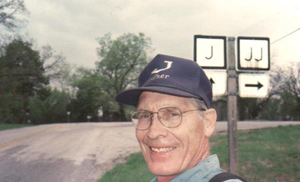 along those J roads.
along those J roads.
Don't ask why.
Maybe he likes to walk alone.
Maybe he wants some fresh air.
Maybe he needs this kind of exercise.
Maybe he hears a different drummer.
Maybe all of these.
From remnants of tallgrass prairie
in Richland County in the southwest
to the great lake shores
surrounding Door County in the northeast
to the fruit orchards and Apostle Islands
of Bayfield County in the far north,
Wisconsin is a land of rivers, booyah,
the (University of) Wisconsin Badgers,
good beer, great lakes, fish boils,
the Green Bay Packers, and potatoes.
But most of all,
as viewed from the its J roads,
Wisconsin is a land of dairy farms.
The J walker lingers in the rain
by a melancholy north-country swamp,
mesmerized by the dimples of the droplets
and gentle sculpting of the wind in the rushes.
He wonders about the rusty tractor
clothed in honeysuckle,
and what stories it could tell
about high times and hard times.
He joins a booyah feed in progress,
anxious to indulge that local custom.
Everywhere he marvels at delicate flowers
and exquisite grasses
flourishing in the roadside hardpan,
without benefit of gardener ministration.
And everywhere he sees silos.
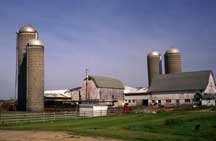 The flow of milk, and milk products,
The flow of milk, and milk products,
is the lifeblood
coursing through Wisconsin's veins.
The J roads,
together with other county roads
from A to Z,
are those veins.
The dairy barns are like hearts,
continually pumping, a beat a day,
into the morning milk trucks.
And the silos are like lungs,
the silage like oxygen,
breathing life from field to barn.
To walk the J roads
is to hitch a ride inside this system,
occasionally passing through
a heart/lung combination,
continually exploring new paths
through the maze of veins.
The roads have the same character
they've had for a century;
perhaps one has been paved recently,
but otherwise is pretty much
the same venerable country road.
As far as the J walker can tell,
the barns and fences and farmhouses
look strikingly like in the 1950s.
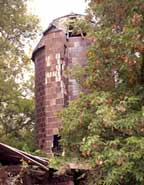 But the silos ...
But the silos ...
the silos, in particular,
fascinate the J walker.
On many farms
the old ceramic/concrete silos,
dairy farm icons of yore,
tower unused above the barn.
Obviously neglected,
host to an occasional errant vine,
claimed by a kind of agricultural emphysema.
Perhaps standing nearby,
towering even higher,
is a gleaming blue steel silo,
encircled with strong steel belts,
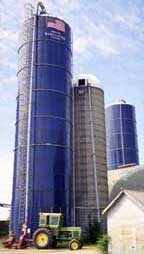 an iron lung to the rescue.
an iron lung to the rescue.
But all too often,
on closer inspection,
the blue has lost its luster,
afflicted with a pox of rust,
or a belt dangles, broken;
the knight in shining armor
is gasping its own last breaths.
And there, along the fence,
the J walker spots a giant white maggot,
bulging segments gleaming in the sun,
seemingly ready to burst,
satiated with silage.
A bag silo,
the J walker learns from a friendly farmer,
a horizontal plastic bag
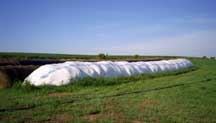 the diameter of a tower silo
the diameter of a tower silo
but two, three, or more, times as long
as the tallest tower silo.
It's as if this giant maggot,
sleeping along the fence by day,
prowls the corn and alfalfa fields
at night,
gobbling the silage on the stalk,
leaving the towers to starve.
On farm after farm the maggots,
"ag-bag" being the catchy name of one brand,
reign supreme as the new dairy lungs.
Then the J walker sees the litter of baby maggots,
a passel of huge white marbles alongside mom.
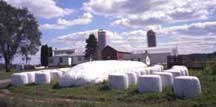 Rampant reproduction.
Rampant reproduction.
Bale silos, the J walker learns later,
large round bales of alfalfa,
baled and bagged wet,
to fermet into little bagettes of silage.
Now it seems clear to the J walker:
the stately tower silos are more permanent
and don't reproduce often.
They're not disposable in this modern era
of disposable everything,
from cameras to clocks,
from dishes to diapers.
And now silos.
Get a new model every year.
No long-term investment, pay-as-you-go.
Don't worry about maintenance.
Hail to the dumps.
And there on the next farm is a dump,
an unsavory-looking pile covered with plastic,
weighted down with cast-off tires.
The J walker discovers that this isn't a dump,
 but a bunker silo.
but a bunker silo.
Green silage is dumped into a trench
and covered with plastic.
This, it turns out,
is the cheapest silo of all,
even with higher rates of spoilage.
Looks like a dump,
thinks the J walker,
looks like a dump.
Every now and then the J walker
comes to a farm without maggots.
The tower silo looks functional,
an original lung not yet victim
to the economic climate
that causes tower asthma.
Alas, such farms
can't catch their breath afterall:
they sprout for-sale signs,
their lifeblood weakened.
Could maggots,
those dramatically evolving silos,
save these farms?
Probably not, thinks the J walker,
but maybe they don't stand a chance otherwise.
Tunk-tunk-tunk, to Marathon County
and the potato harvest.
Potato diggers instead of silos,
potato trucks instead of milk trucks,
make Wisconsin
the third largest potato-producing state.
But across the vast potato field
there's a distant tower silo
poking up over the horizon.
What accompanies it,
wonders the J walker,
a maggot or a for-sale sign?
Then on to Outgamie County
and the shores of Green Bay,
fish boil country.
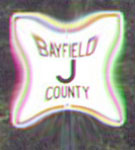 White fish from Lake Michigan and potatoes
White fish from Lake Michigan and potatoes
are boiled together in a big pot;
the whole community turns out for the feast.
Bayfield County is fruit country,
apples and raspberries and a whole lot more.
Vilas County is small lake country,
thousands of lakes, most fairly tiny.
The J road in Pepin County has two prongs,
both ending up on the Mississippi River,
so this is big river country.
It is a land of tremendous variety,
but not a day or J road,
barely a mile,
goes by without the ever-present silos
pummeling the J walker
with a kaleidoscope of images
and implications.
Tunk-tunk-tunk.
|
 he old man ambles along
he old man ambles along Mile after lovely lonely mile.
Mile after lovely lonely mile. along those J roads.
along those J roads. The flow of milk, and milk products,
The flow of milk, and milk products, But the silos ...
But the silos ...  an iron lung to the rescue.
an iron lung to the rescue. the diameter of a tower silo
the diameter of a tower silo Rampant reproduction.
Rampant reproduction. but a bunker silo.
but a bunker silo. White fish from Lake Michigan and potatoes
White fish from Lake Michigan and potatoes